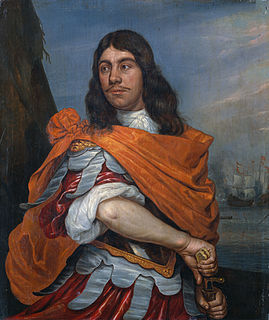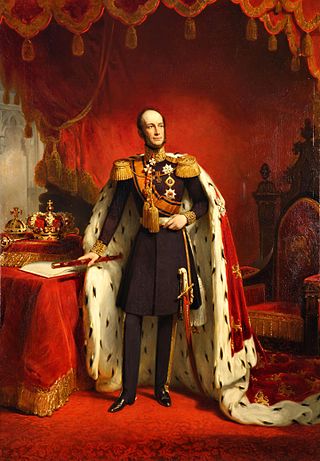
William I was a Prince of Orange, the King of the Netherlands and Grand Duke of Luxembourg.

The House of Orange-Nassau is the current reigning house of the Netherlands. A branch of the European House of Nassau, the house has played a central role in the politics and government of the Netherlands and Europe especially since William the Silent organised the Dutch Revolt against Spanish rule, which after the Eighty Years' War (1568–1648) led to an independent Dutch state.

William V was a prince of Orange and the last stadtholder of the Dutch Republic. He went into exile to London in 1795. He was furthermore ruler of the Principality of Orange-Nassau until his death in 1806. In that capacity he was succeeded by his son William.

William the Silent, also known as William the Taciturn, or, more commonly in the Netherlands, William of Orange, was the main leader of the Dutch Revolt against the Spanish Habsburgs that set off the Eighty Years' War (1568–1648) and resulted in the formal independence of the United Provinces in 1648. Born into the House of Nassau, he became Prince of Orange in 1544 and is thereby the founder of the Orange-Nassau branch and the ancestor of the monarchy of the Netherlands. In the Netherlands, he is also known as Father of the Fatherland.

John William Friso became the (titular) Prince of Orange in 1702. He was the Stadtholder of Friesland and Groningen in the Dutch Republic until his death by accidental drowning in the Hollands Diep in 1711. From World War II to 2022, Friso and his wife, Marie Louise, were the most recent common ancestors of all current European monarchs.

Prince of Orange is a title originally associated with the sovereign Principality of Orange, in what is now southern France and subsequently held by sovereigns in the Netherlands.

The coat of arms of the Kingdom of the Netherlands was originally adopted in 1815 and later modified in 1907. The arms are a composite of the arms of the former Dutch Republic and the arms of the House of Nassau, it features a checkered shield with a lion grasping a sword in one hand and a bundle of arrows in the other and is the heraldic symbol of the monarch and the country. The monarch uses a version of the arms with a mantle while the government of the Netherlands uses a smaller version without the mantle (cloak) or the pavilion, sometimes only the shield and crown are used. The components of the coats of arms were regulated by Queen Wilhelmina in a royal decree of 10 July 1907, affirmed by Queen Juliana in a royal decree of 23 April 1980.

Prince Frederick of the Netherlands, Prince of Orange-Nassau, was the second son of William I of the Netherlands and his wife, Wilhelmine of Prussia.
The Kew Letters were a number of letters, written by stadtholder William V, Prince of Orange between 30 January and 8 February 1795 from the "Dutch House" at Kew Palace, where he temporarily stayed after his trip to England on 18 January 1795. The letters were written in his capacity of Captain-general of the Dutch Republic to the civil and military authorities in the provinces of Zeeland and Friesland, to the officers commanding Dutch naval vessels in British harbours and to Dutch colonial governors. It urged them to continue resistance in cooperation with Great Britain against the armed forces of the French Republic that had invaded the Dutch Republic and forced him to flee to England. In particular the letters to the colonial governors played an important role, because they ordered them to surrender those colonies to the British.

In the history of the Dutch Republic, Orangism or prinsgezindheid was a political force opposing the Staatsgezinde (pro-Republic) party. Orangists supported the Princes of Orange as Stadtholders and military commanders of the Republic, as a check on the power of the regenten. The Orangist party drew its adherents largely from traditionalists – mostly farmers, soldiers, noblemen and orthodox Protestant preachers, though its support fluctuated heavily over the course of the Republic's history and there were never clear-cut socioeconomic divisions.

William II was King of the Netherlands, Grand Duke of Luxembourg, and Duke of Limburg.
Nassau-Orange-Fulda was a short-lived principality of the Holy Roman Empire from 1803 to 1806. It was created for William Frederick, the son and heir of William V, Prince of Orange, the ousted stadtholder of the abolished Dutch Republic after the Batavian Revolution of 1795.

Prince Frederik of Orange-Nassau was the youngest son of William V, Prince of Orange and Stadtholder of the Dutch Republic and Princess Wilhelmina of Prussia, sister of King Frederick William II. Commonly called Fritz inside the family, he chose a military career with the Holy Roman Empire, he died of a fever while serving in Padua, Italy.

The King's Dutch Brigade was a brigade of the British army, organised by the Hereditary Prince of Orange out of former officers and lower ranks of the former Dutch States Army, deserters from the Batavian army, and mutineers from the Batavian fleet that had surrendered to the Royal Navy in the Vlieter Incident during the Anglo-Russian invasion of Holland in 1799, but fully in British service and paid for by the British government. It was commissioned on 21 October 1799 and was initially in garrison on the Isle of Wight and in Lymington. It saw service in Ireland in 1801, and afterwards back to the Isle of Wight and Lymington as well as to the Channel Islands of Jersey and Guernsey. The orders for the brigade to be disbanded were issued on 12 July 1802, as agreed in the Treaty of Amiens of 25 March 1802.

Marquis of Veere and Flushing is one of the titles of the kings and queens of the Netherlands. It was originally a Dutch title of nobility referring to the cities of Veere and Vlissingen, in the southwestern Netherlands. Holy Roman Emperor Charles V created the title in 1555 for his distant relative, Maximilian of Burgundy, who had by then ruled as Lord of Veere. After being held by the kings of Spain and England and claimed by the kings in Prussia, it definitively passed to the House of Orange-Nassau.

Republicanism in the Netherlands is a movement that strives to abolish the Dutch monarchy and replace it with a republic. The popularity of the organised republican movement that seeks to abolish the monarchy in its entirety has been suggested to be a minority among the people of the Netherlands, according to opinion polls. On the other hand, there has shown to be political and popular support in the Netherlands for reducing the political powers and the subsidies of the royal house.

The Act of Guarantee of the hereditary stadtholderate was a document from 1788, in which the seven provinces of the States General and the representative of Drenthe declared, amongst other things, that the admiralty and captain-generalship were hereditary, and together with the hereditary stadtholderate would henceforth be an integrated part of the constitution of the Dutch Republic. Moreover, members of the House of Orange-Nassau would have the exclusive privilege to hold the office. The Act was in force until the Batavian Republic was established in 1795.

Maria of Nassau or Maria of Orange-Nassau was a Dutch princess of the house of Orange and by marriage pfalzgräfin or countess of Simmern-Kaiserslautern.

Schloss Oranienstein is one of the palaces of the House of Orange-Nassau, sited at Diez on the Lahn. It was built on the ruins of Dierstein Abbey between 1672 and 1681 for Countess Albertine Agnes of Nassau after she was widowed.

The siege of Nijmegen occurred from 27 October to 8 November 1794 during the Flanders campaign of the War of the First Coalition. It was the last major military confrontation between the forces of the Revolutionary French First Republic and the reactionary First Coalition of European monarchs including William V, Prince of Orange, before the fall of the Dutch Republic in January 1795, which William had ruled as hereditary stadtholder since 1751. As commander-in-chief of the Dutch States Army, his indecision, several changes of mind and lack of coordination with his Anglo-Hanoverian, Hessian, Prussian and Austrian allies contributed to the eventual surrender of Nijmegen to the French revolutionaries.


















